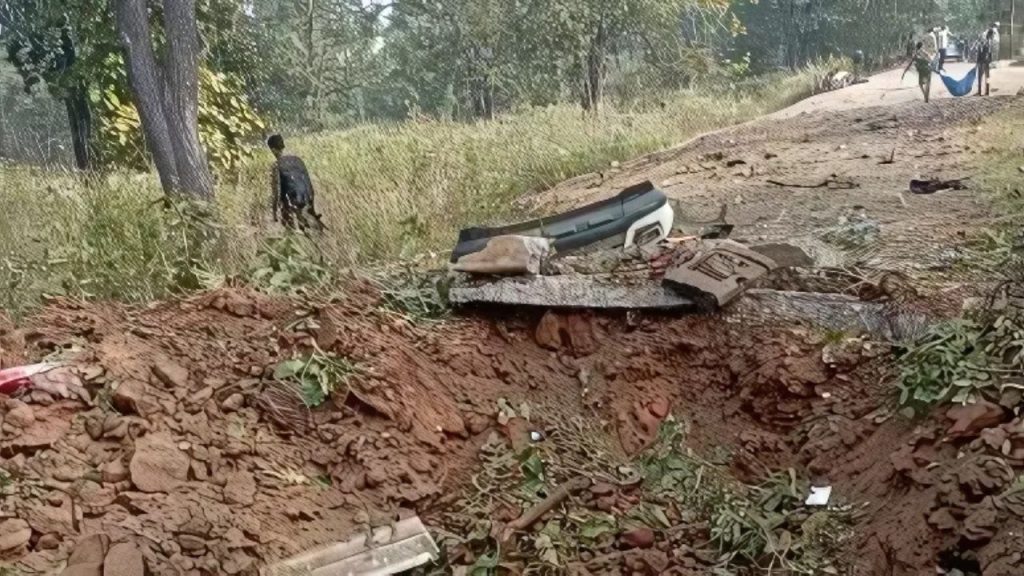
On a tragic day in Chhattisgarh, at least nine police officers lost their lives when a police vehicle was targeted and blown up by Naxalites in the Bijapur district. The incident, which occurred on a remote road in the district, is a stark reminder of the ongoing insurgency in India’s central region, where Naxalites, or Maoist insurgents, continue to challenge the state’s authority, using violent methods in their fight for a greater share of resources, land, and power for tribal populations.
The Attack
The attack took place when a police convoy, which was part of a larger operation, was moving through the dense forest areas of Bijapur, a district that has been a hotbed of Naxalite activity. The Naxalites set off an explosive device that was strategically placed along the road, targeting the police vehicle. The explosion was powerful enough to completely destroy the vehicle, killing at least nine personnel instantly. Several others were injured in the blast and have been rushed to nearby hospitals.
Local authorities confirmed that the vehicle was part of a team that had been deployed for a counter-insurgency operation aimed at rooting out Naxalite militants who have been active in the region for several decades. The police convoy was not expecting such a lethal attack and were caught off guard, though security forces have continued to maintain their operations in the area.
The Naxalite Movement: A Deep-Rooted Issue
The Naxalite insurgency has its origins in the 1960s, when communist ideologies advocating for land redistribution and better rights for tribal populations took hold in rural India. Over the years, the movement grew and spread, with Naxalites waging a violent campaign against the state, targeting police forces, government officials, and civilian infrastructure.
In areas like Bijapur, which lie in the heart of India’s so-called “Red Corridor,” the Naxalite presence remains strong. This corridor includes parts of Chhattisgarh, Jharkhand, Odisha, Bihar, Maharashtra, and Andhra Pradesh, where Maoist insurgents have established strongholds due to the underdevelopment and alienation of tribal populations. Despite several operations by the state to control Naxalite activities, the insurgents continue to pose a significant challenge to the authorities.
The reasons behind the persistence of the Naxalite movement are complex. At the core of their ideology is the fight for social justice and equal rights, particularly for tribal and marginalized communities who feel disenfranchised by the state. The Naxalites have tapped into widespread discontent regarding issues like land acquisition, displacement of indigenous people, and the lack of access to basic amenities such as healthcare, education, and employment.
However, the use of violence and terror as a means to achieve these goals has attracted widespread condemnation. The insurgents frequently engage in bombings, ambushes, and other attacks against state forces and civilians alike, causing loss of life, destruction, and fear in the affected areas. The latest incident in Bijapur is just one in a series of attacks that have shaken the region in recent months.
The Response of the Authorities
Following the attack in Bijapur, there was an immediate response from Chhattisgarh’s state authorities, with the local police and paramilitary forces launching a manhunt to apprehend those responsible for the bombing. The region’s security forces have been put on high alert, and counter-insurgency operations have been intensified to track down the perpetrators.
The state government condemned the attack and expressed its condolences to the families of the fallen officers. Chief Minister Bhupesh Baghel offered his sympathies and assured that the state would continue to take all necessary steps to ensure the safety and security of law enforcement personnel. The attack has also drawn condemnation from other political leaders, who expressed their support for the police forces and pledged to work together to eradicate the Naxalite menace.
At the national level, the government has also reaffirmed its commitment to fighting the Naxalites. Union Home Minister Amit Shah, while offering condolences to the victims’ families, stated that the government would not relent in its efforts to combat the Naxalite insurgency. He also emphasized the importance of strengthening security in Naxal-affected regions and providing the necessary support to law enforcement agencies working in these difficult and dangerous areas.
The Human Cost of Naxalite Violence
The loss of life in Bijapur is part of a much larger tragedy that has affected not only security personnel but also the civilian population in regions controlled by Naxalites. Thousands of innocent lives have been lost over the years due to the violence perpetrated by both the Naxalites and the security forces.
While the Naxalites argue that they are fighting for the rights of the marginalized, their violent tactics have often alienated the very people they claim to represent. Civilians in these regions find themselves caught in the crossfire, suffering from the effects of ongoing violence, displacement, and the destruction of their livelihoods. The remote locations of many of these areas make it difficult for the government to deliver services, further deepening the sense of alienation and frustration among the local populations.
On the other hand, the security forces are tasked with maintaining law and order in highly volatile and challenging environments. Despite the constant danger they face, many police officers and paramilitary personnel continue to serve in these regions, often at great personal risk. The families of those killed in such attacks, as in the case of the Bijapur bombing, endure a heavy emotional and financial toll.
The Road Ahead
The tragic events in Bijapur underscore the urgent need for a long-term solution to the Naxalite insurgency. While security forces continue to work on neutralizing the threat posed by the insurgents, there must also be a concerted effort to address the root causes of the conflict.
Efforts should be focused on improving the socio-economic conditions of tribal and rural populations, particularly in Naxal-affected regions. Investments in infrastructure, healthcare, education, and employment opportunities could help reduce the appeal of the Naxalites, who often exploit the grievances of these communities. Additionally, addressing issues like land rights, displacement, and lack of access to basic services would go a long way in building trust between these communities and the state.
However, achieving lasting peace in these regions is not easy. The Naxalite movement is entrenched in the social fabric of these areas, and any solution will require a multi-faceted approach, involving both security measures and development initiatives. Moreover, any lasting peace will require cooperation between the central government, state governments, and local communities.
Conclusion
The attack in Bijapur, where nine police officers lost their lives, is a tragic reminder of the ongoing Naxalite insurgency in central India. While the security forces continue to combat this threat with determination and resilience, it is clear that a broader approach is needed to address the underlying issues driving the conflict. Until the grievances of marginalized communities are addressed and their socio-economic conditions improve, it is unlikely that the cycle of violence will come to an end.
As India moves forward in its fight against Naxalite insurgency, it is crucial to remember that the true solution lies not just in military action, but in creating a more inclusive and equitable society that leaves no one behind.
